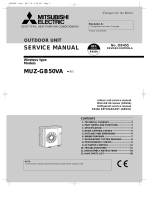
9
(2) Cold air prevention control
MSZ-A09/12/15/17 MSZ-FD MSZ-D
When the compressor is not operating,
(
) if the temperature of room temperature thermistor is less than 66 °F, the fan stops.
(
) if the temperature of room temperature thermistor is 66 °F or more and
(
) if the temperature of indoor coil themistor is less than 32 °F, the fan stops.
(
) if the temperature of indoor coil themistor is 32 °F or more, the fan operates at Very Low.
When the compressor is operating,
(
) if the temperature of indoor coil themistor is 104 °F or more, the fan operates at set speed.
(
) if the temperature of indoor coil themistor is less than 104 °F and
(
) if heating operation starts after defrosting, the fan stops.
(
) if the temperature of room temperature thermistor is 66 °F or less, the fan stops.
(
) if the temperature of room temperature thermistor is more than 66 °F, the fan operates at Very Low.
NOTE : When 3 minutes have passed since the compressor started operation, this control is released regardless of the
temperature of room temperature thermistor and indoor coil thermistor.
MSZ-A24
When the compressor is not operating,
(
) if the temperature of room temperature thermistor is 59 °F or less, or temperature of indoor coil thermistor is
less than 64 °F, the fan stops.
(
) if the temperature of room temperature thermistor is more than 59 °F, or temperature of indoor coil themistor is
more than 64 °F, the fan operates at Very Low.
When the compressor is operating,
(
) if the temperature of indoor coil themistor is 64 °F or more, the fan operates at set speed.
(
) if the temperature of indoor coil themistor is less than 64 °F and
( ) if heating operation starts after defrosting, the fan stops.
( ) if the temperature of room temperature thermistor is 59 °F or less, the fan stops.
( ) if the temperature of room temperature thermistor is more than 59 °F, the fan operates at Very Low.
NOTE : When 3 minutes have passed since the compressor started operation, this control is released regardless of the
temperature of room temperature thermistor and indoor coil thermistor.
(3) Warm air control (MSZ-FD)
When the following any condition of (a. ~ c.) and the condition of are satisfied at the same time, warm air control
works.
a.) Fan speed is used in MANUAL.
b.) When cold air prevention has been released.
c.) When defrosting has been finished.
When the temperature of indoor coil thermistor is less than 104 °F.
When warm air control works, the fan speed changes as follows to blow out warm air gradually.
Gradation of fan speed in initial
<Time condition> <Indoor fan speed>
Less than 2 minutes ------------ Low
2 minutes to 4 minutes -------- Med.
More than 4 minutes ----------- High or Super high
The upper limit of the fan speed in MANUAL is the set speed.
When the temperature of indoor coil thermistor has been 104 °F or more, or when the set speed has been changed, this
control is released and the fan speed is the set speed.
3. Overload starting
When the room temperature thermistor reads 64 °F or more, the compressor runs with its maximum frequency regulated for
10 minutes after the start-up.
4. Defrosting
(1) Starting conditions of defrosting
When the following conditions a) ~ c) are satisfied, the defrosting starts.
a) The defrost thermistor reads 27 °F or less.
b) The cumulative operation time of the compressor has reached any of the set values
(40, 45, 55, 65, 75, 85, 95, 105,
115, 125, 150 minutes.
c) More than 5 minutes have passed since the start-up of the compressor.
Set value of compressor operation time (here in after referred to as defrost interval)
This is decided by the temperature of defrost thermistor, ambient temperature thermistor, and the previous defrosting
time. For example, the first defrost interval is 40 minutes long, and the second is 45 minutes long. The third and sub-
sequent intervals are set to be longer, and less frequent, depending on defrosting time.
The third and subsequent defrost intervals follow any of the three patterns
…
5 or 10 to 20 minutes longer, the same,
or 5 or 10 to 20 minutes shorter compared with the previous defrost interval
…
with the longest 125 minutes and the
shortest 40 minutes.





















